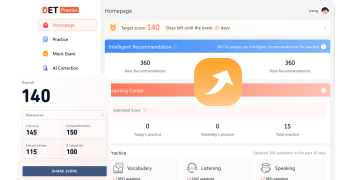พิชิตความท้าทาย ‘อ่านก่อนแล้วเขียน’ ในการทดสอบภาษาอังกฤษของ Duolingo
ยินดีต้อนรับผู้ที่ชื่นชอบภาษาอังกฤษและผู้เข้าสอบ Duolingo English Test! วันนี้เราจะพาคุณสำรวจส่วน 'Read, Then Write’ ของ DET ซึ่งเป็นส่วนสำคัญของการสอบที่ประเมินความสามารถในการเข้าใจและผลิตงานเขียนภาษาอังกฤษได้อย่างมีประสิทธิภาพ หลายคนพบว่าส่วนนี้น่ากลัวเนื่องจากข้อจำกัดด้านเวลาและความลึกซึ้งของการตอบ แต่ไม่ต้องกังวล! โพสต์นี้คือคู่มือยุทธศาสตร์ของคุณที่จะไม่เพียงแค่ทำให้คุณเข้าถึงส่วนนี้ด้วยความมั่นใจ แต่ยังสามารถเชี่ยวชาญในมันอีกด้วย
งาน ' Read, Then Write’ จะนำเสนอข้อควา มให้คุณสร้างการตอบกลับภายใน 5 นาที ฟังดูท้าทายใช่ไหม? แต่ด้วยวิธีการที่ถูกต้อง คุณสามารถเปลี่ยนความท้าทายนี้ให้เป็นโอกาสในการแสดงความชำนาญในภาษาอังกฤษของคุณ ไม่ว่าคุณจะเป็นผู้พูดภาษาอังกฤษที่มีประสบการณ์หรือเป็นผู้เรียนภาษาไกด์นี้จะให้อุบายจริง การจัดการเวลาที่เป็นประโยชน์ และแม้แต่เทมเพลตตอบกลับเพื่อให้แน่ใจว่าคุณจะประสบความสำเร็จ ดังนั้น มาร่วมเดินทางไปด้วยกันและเปลี่ยนการเขียนของคุณจากดีเป็นยอดเยี่ยม!
จงติดตามคำแนะนำที่เจาะลึกเกี่ยวกับการเข้าใจข้อความ การจัดโครงสร้างการตอบกลับ การเพิ่มพูนคำศัพท์ของคุณ และอีกมากมาย พร้อมกับเทมเพลตที่ปรับได้ที่จะช่วยให้การฝึกฝนของคุณเดินในเส้นทางที่ถูกต้อง คุณพร้อมที่จะเก่งในส่วน 'Read, Then Write’ หรือยัง? มาลุยกันเลย!

1. การเข้าใจข้อความ: กุญแจสำคัญของการตอบสนองตรงจุด
การดำดิ่งเข้าสู่ส่วน 'Read, Then Write’ เริ่มต้นด้วยขั้นตอนสำคัญหนึ่ง: การเข้าใจข้อความ ส่วนนี้เรียกร้องไม่เพียงแค่ทักษะภาษา แต่ยังรวมถึงความสามารถในการวิเคราะห์ นี่คือวิธีทำให้แน่ใจว่าคุณกำลังอยู่ในเส้นทางที่ถูกต้อง:
อันดับแรก แยกแยะข้อควมออกเป็นองค์ประกอบพื้นฐาน หัวข้อหลักคืออะไร? มีรายละเอียดเฉพาะหรือการเปรียบเทียบที่ถามถึงไหม? การระบุองค์ประกอบเหล่านี้เป็นสิ่งจำเป็นสำหรับการตอบสนองที่เกี่ยวข้อง
อันดับที่สอง ระบุประเภทของคำถาม มันถามหาคำตอบเชิงบรรยายที่คุณต้องอธิบายความคิดพร้อมกับตัวอย่าง หรือว่าเป็นคำถามเชิงโต้เถียงที่คุณต้องยืนหยัดจุดยืนของคุณ? วิธีการของคุณจะขึ้นอยู่กับความแตกต่างนี้
สุดท้าย ให้ความสนใจกับคำสั่ง คำอย่าง ‘describe,’ ‘compare,’ หรือ ‘argue’ ให้ข้อมูลโดยตรงเกี่ยวกับสิ่งที่ผู้ตรวจสอบต้องการ หากคุณละเลยคำเหล่านี้ อาจนำคุณไปในทิศทางที่ผิด
ตัวอย่างเช่น ข้อความ: “พูดถึงครั้งสุดท้ายที่คุณรู้สึกกลัวที่จะทำบางสิ่งใหม่ ๆ แต่ทำมันอยู่ดี คุณหาพละกำลังที่จะลองทำอย่างไร? คุณเรียนรู้อะไรจากประสบการณ์นี้ที่จะช่วยคุณในชีวิต?”
ในการแยกแยะข้อความนี้ ให ้ระบุสามองค์ประกอบหลัก: ประสบการณ์ส่วนตัวของความกลัว การเอาชนะความกลัวนั้น และบทเรียนชีวิตที่ได้เรียนรู้ มันเป็นคำบรรยายแต ่ก็สะท้อนอยู่ในตัว ต้องการไม่เพียงแค่การเล่าถึงเหตุการณ์ แต่ยังรวมถึงการเข้าใจส่วนบุคคลด้วย
ระบุคำที่ต้องกระทำ: ‘talk,’ ‘found the strength,’ และ ‘learned.’ คำเหล่านี้ชี้นำให้คุณแชร์เรื่องราว สะท้อนถึงความแข็งแกร่งภายในของคุณ และขยายบทเรียนชีวิตที่ใหญ่ขึ้น
จำไว้ว่างานนี้ไม่ได้ถามเพียงแค่สิ่งที่เกิดขึ้น มันเชิญชวนให้คุณเล่าเรื่องราวและสะท้อนสิ่งที่เกิดขึ้น การเข้าใจข้อนี้อย่างเต็มที่ การตอบของคุณจะไม่เพียงแค่เล่าเรื่อง แต่ยังเป็นการเผยให้เห็นการเติบโตส่วนบุคคลของคุณ ซึ่งตรงกับสิ่งที่ข้อความต้องการอย่างสมบูรณ์
จำไว้ว่าข้อความคือแผนที่นำทางของคุณ การเข้าใจมันไม่ใช่เพียงแต่ก้าวแรก มันคือพื้นฐานของการตอบสนองที่น่าสนใจที่จะสะท้อนกับผู้ตรวจสอบ ดังนั้นใช้เวลาสักครู่ อ่านมันอย่างละเอียด และปล่อยให้ความชัดเจนนำทางปากกาของคุณ!
2. การจัดการเวลามืออาชีพ:
การจัดการเวลาให้เชี่ยวชาญมีความสำคัญเมื่อคุณมีเพียงห้านาทีในการตอบสนอง นี่คือการแบ่งเวลาเชิงยุทธศาสตร์:
วางแผนอย่างเร็ว: ใช้เวลาหนึ่งนาทีในการระดมความคิดและสร้างโครงร่าง เขียนแนวคิดและจุดที่คุณต้องการที่จะพูด
เขียนอย่างมีประสิทธิภาพ: จัดสรรเวลาสามนาทีในการเขียน ยึดตามโครงร่างของคุณและเก็บประโยคให้กระชับ มุ่งเน้นที่ความชัดเจนและความแม่นยำ
ตรวจสอบอย่างมีประสิทธิผล: สำรองนาทีสุดท้ายสำหรับการตรวจสอบ ตรวจสอบหาข้อผิดพลาดทางไวยากรณ์ ตรวจสอบว่าคุณตอบทุกส่วนของข้อความแล้ว และปรับปรุงประโยคที่ดูเทอะทะ
โดยการจัดโครงสร้างเวลาของคุณอย่างชาญฉลาด คุณจะมั่นใจว่าการตอบสนองของคุณมีความชัดเจน สมบูรณ์ และเป็นระเบียบ จำไว้ว่าคำตอบที่เสร็จสิ้นภายในเวลาที่กำหนดดีกว่าผลงานชั้นยอดที่ไม่เสร็จ
3. การจัดโครงสร้างการตอบสนองของคุณ: รักษามันให้เรียบง่ายและชัดเจน
ด้วยเวลาห้านาทีสำหรับส่วน ‘Read, Then Write’ ความเรียบง่ายเป็นกุญแจ นี่คือวิธีการจัดโครงสร้างการตอบสนองที่ชัดเจนและมีประสิทธิภาพ:
บทนำ: เริ่มต้นด้วยประโยคตรงไปตรงมาที่ตอบโจทย์ข้อความโดยตรง หากข้อความเกี่ยวกับประสบการณ์ส่วนตัว เริ่มต้นด้วยคำกล่าวที่สั้นๆ ที่ตั้งฉาก
เนื้อหา: เลือกจุดสำคัญหนึ่งหรือสองจุดในการพัฒนา หากคุณกำลังอธิบายประสบการณ์ ให้มุ่งเน้นไปที่ส่วนที่มีผลมากที่สุด หากคุณกำลังโต้เถียง ให้กล่าวถึงเหตุผลหลักของคุณและสนับสนุนมันอย่างสั้นๆ
สรุป: จบลงด้วยคำสั้น ๆ ที่สะท้อนประสบการณ์หรือตอกย้ำจุดของคุณ ทำให้มันสอดคล้องแต่สั้น
โครงสร้างที่เรียบง่ายนี้จะมั่นใจว่าการตอบสนองของคุณเป็นระเบียบและคุณไม่หลุดไปจากข้อความ ทำให้คุณใช้เวลาที่จำกัดอย่างเต็มที่
ด้วยข้อความ “Talk about the last time you felt scared to do something new, but you did it anyway. How did you find the strength to try it? What did you learn from this experience that will help you in life?” มาลองแสดงโครงสร้างที่ตรงไปตรงมากัน:
บทนำ: “Facing my long-standing fear of heights, I decided to try rock climbing, an activity that both terrified and intrigued me.”
เนื้อหา: “Initially, the very thought of climbing filled me with dread. However, recognizing the importance of confronting my fears, I started with small, manageable climbs. I sought guidance from experienced climbers and gradually built my confidence through their support and my persistent practice. This journey was not just about climbing but about learning to trust in my abilities and the support of those around me. The moment I reached the top of my first significant climb, the overwhelming sense of achievement eclipsed any fear I had felt.”
สรุป: “This experience taught me that facing fears head-on, with preparation and support, can lead to profound personal growth.”
ตัวอย่างนี้ยึดตามโครงสร้างที่เรียบง่ายของบทนำ เนื้อหา และสรุป ใส่การตอบสนองที่มีความเข้าใจและมีผลกระทบในรูปแบบที่กระชับเหมาะสมสำหรับงานเขียนห้านาที
4. ความลึกมากกว่าความกว้าง: การสร้างการตอบสนองที่มีความหมาย
การมุ่งเน้นไปที่ความลึกมากกว่าการพยายามครอบคลุมมากเกินไปมีความสำคัญสำหรับส่วน ‘Read, Then Write’ นี่หมายถึงการเลือกจุดสำคัญหนึ่งหรือสองจุดและสำรวจมันอย่างละเอียด ใช้ตัวอย่างเชิงเฉพาะและข้อมูลเชิงลึกส่วนตัวเพื่อสร้างการตอบสนองที่มีความหมาย การทำเช่นนี้ไม่เพียงแต่แสดงความสามารถของคุณในการวิเคราะห์และสะท้อน แต่อย่างใดยังทำให้การเขียนของคุณน่าสนใจและมีความหมายมากขึ้น พยายามแสดงความเข้าใจเชิงลึกในหัวข้อที่เกี่ยวข้อง ซึ่งจะทำให้การตอบสนองของคุณโดดเด่นในสายตาของผู้ประเมิน
5. ภาษาและคำศัพท์: ศิลปะแห่งความแม่นยำและความหลากหลาย
การใช้คำศัพท์ที่หลากหลายและแม่นยำเป็นสิ่งสำคัญในส่วน ‘Read, Then Write’ ตั้งเป้าที่จะใช้คำที่เฉพาะเจาะจงและแสดงอารมณ์ที่สื่อความคิดและความรู้สึกของคุณอย่างถูกต้อง นี่ไม่ได้หมายถึงการใช้คำที่ซับซ้อนหรือยากเกินไปที่อาจทำให้ผู้อ่านสับสน แต่อย่างใดให้มุ่งเน้นที่ความชัดเจนและความแม่นยำในการเลือกใช้คำของคุณ การใช้คำพ้องอย่างรอบคอบสามารถเพิ่มความลึกให้กับข้อความของคุณโดยไม่ลดทอนความเข้าใจของผู้อ่าน นอกจากนี้ การใช้ไวยากรณ์และโครงสร้างประโยคอย่างถูกต้องก็เป็นสิ่งสำคัญในการสื่อสารความคิดของคุณอย่างมีประสิทธิภาพและสร้างความประทับใจที่ดีต่อผู้ประเมิน
ในการปรับปรุงการตอบสนองโดยการใช้คำศัพท์ที่หลากหลายและแม่นยำ คุณอาจพิจารณาการปรับปรุงดังนี้:
บทนำ: “Confronted by my perennial dread of altitudes, I embraced rock climbing, a venture that both daunted and captivated me.”
เนื้อหา: “The notion of ascending vertical faces initially paralyzed me with fear. Acknowledging the necessity to confront my apprehensions, I embarked on modest ascents, under the tutelage of seasoned climbers. Their mentorship, coupled with my steadfast dedication, gradually fortified my confidence. This odyssey was not merely about climbing; it was an expedition in self-discovery and trust. Achieving the summit of my inaugural significant climb was a testament to surmounting fears through perseverance and communal support.”
สรุป: “This odyssey illuminated the essence of bravery, tenacity, and the significance of stepwise progression. It underscored that engaging directly with one’s fears, equipped with preparation and camaraderie, catalyzes profound self-evolution. These lessons serve as invaluable compasses for navigating future adversities with a fortified resolve.”
เวอร์ชันนี้ใช้คำศัพท์ที่หลากหลายมากขึ้นและภาษาที่น่าอธิบายกว้างขวางกว่าเพื่อเล่าประสบการณ์อย่างชัดเจนและสะท้อนความรู้สึกอย่างลึกซึ้ง แสดงให้เห็นว่าการเลือกใช้ภาษาที่แม่นยำเพิ่มความลึกและผลกระทบของเรื่องเล่าให้สูงขึ้นได้อย่างไร
6. เทมเพลตสำหรับความสำเร็จ: วิธีการที่เป็นโครงสร้างสำหรับประเภทคำถามต่างๆ
ในการทำงานกับคำถาม ‘Read, Then Write’ อย่างมีประสิทธิภาพ ให้พิจารณาเทมเพลตง่ายๆ เหล่านี้ที่ปรับให้เหมาะสมกับคำถามทั้งแบบบรรยายและแบบโต้เถียง:
เทมเพลตคำถามบรรยาย:
- บทนำ: แนะนำสถานการณ์หรือประสบการณ์สั้นๆ
- เนื้อหา: อธิบายประสบการณ์ด้วยรายละเอียดเชิงเฉพาะ โดยมุ่งเน้นไปที่ข้อมูลเชิงความรู้สึกและอารมณ์เพื่อทำให้เรื่องราวมีชีวิตชีวา
- สรุป: สะท้อนประสบการณ์โดยให้ความสำคัญกับการเติบโตส่วนบุคคลหรือข้อมูลเชิงลึกที่ได้รับ
เทมเพลตคำถามโต้เถียง:
- บทนำ: กล่าวตำแหน่งของคุณอย่างชัดเจน
- เนื้อหา: นำเสนอข้อโต้แย้งหนึ่งหรือสองข้อที่แข็งแกร่งซึ่งได้รับการสนับสนุนจากตัวอย่างหรื
การอธิบายและการสรุปความเห็นของคุณ
คำถามบรรยาย: การบรรยายประสบการณ์ของคุณ
คำถามโต้เถียง: การเสนอมุมมองและการสนับสนุนข้อคิดเห็นของคุณ
7. การตรวจทาน: การเพิ่มคุณภาพผ่านความใส่ใจในรายละเอียด
การตรวจทานเป็นขั้นตอนสุดท้ายที่สำคัญในการทำให้การตอบสนอง ‘Read, Then Write’ ของคุณโดดเด่น ขั้นตอนนี้ไม่เพียงแต่เกี่ยวกับการค้นหาข้อผิดพลาดทางการสะกดคำ; มันเป็นการตรวจสอบอย่างครอบคลุมเพื่อเพิ่มความชัดเจน ความสอดคล้อง และผลกระทบ กำหนดเวลาอย่างน้อยหนึ่งนาทีสำหรับกระบวนการนี้ โดยทำตามขั้นตอนเหล่านี้:
1. ตรวจสอบความครบถ้วน: ทบทวนข้อความเพื่อยืนยันว่าการตอบสนองของคุณครอบคลุมทุกประเด็น การพลาดส่วนหนึ่งของคำถามสามารถส่งผลอย่างมากต่อคะแนนของคุณ
2. ตรวจทานไวยากรณ์และโวหาร: ค้นหาข้อผิดพลาดทางไวยากรณ์ที่พบบ่อย เช่น ความสอดคล้องระหว่างประธานและกิริยา ใช้กาลผิดที่ และคำขยายที่วางไม่ถูกต้อง ตรวจสอบให้แน่ใจว่าประโยคไหลลื่นและการใช้เครื่องหมายวรรคตอนเพิ่มความอ่านง่าย
3. คำศัพท์และความชัดเจน: ตรวจสอบให้แน่ใจว่าการเลือกคำของคุณแม่นยำและเหมาะสมกับบริบท แทนที่คำที่คลุมเครือด้วยคำที่เฉพาะเจาะจงเพื่อเพิ่มความลึกให้กับเนื้อหาของคุณ
4. การไหลลื่นของตรรกะ: ประเมินการจัดลำดับความคิดของคุณ ตรวจสอบให้แน่ใจว่าบทความแต่ละย่อหน้าค่อยๆ เปลี่ยนไปยังย่อหน้าต่อไป รักษาลำดับความคิดที่มีตรรกะ
5. ลบข้อซ้ำซ้อน: ลบคำพูดซ้ำหรือคำที่ไม่จำเป็น ความกระชับเป็นกุญแจสำคัญของการเขียนที่ชัดเจนและมีพลัง
6. อ่านออกเสียง: การฟังข้อความของคุณสามารถเปิดเผยการ
คำพูดที่ดูเทอะทะและข้อผิดพลาดที่มองข้ามไปได้ซึ่งการอ่านเงียบอาจพลาดได้
7. ตรวจสอบการสะกดคำครั้งสุดท้าย: แม้ว่าจะมีการตรวจสอบการสะกดคำ แต่บางข้อผิดพลาดสามารถหลุดรอดไปได้ โดยเฉพาะอย่างยิ่งกับคำที่ออกเสียงเหมือนกันหรือการเลือกคำที่ไม่ถูกต้องซึ่งยังเป็นคำที่ถูกต้อง
โดยการรวมกลยุทธ์การตรวจทานเหล่านี้ การตอบสนองของคุณจะไม่เพียงแค่ถูกต้องตามไวยากรณ์ แต่ยังมีความน่าสนใจและมีประสิทธิภาพมากขึ้น กระบวนการปรับแต่งอย่างรอบคอบนี้สามารถยกระดับการเขียนของคุณ ทำให้คุณสร้างความประทับใจที่ยั่งยืนต่อผู้ประเมิน
ตลอดคู่มือนี้เราได้สำรวจกลยุทธ์ที่สำคัญและเทมเพลตที่ใช้งานได้จริงเพื่อช่วยนำทางในส่วน ‘Read, Then Write’ ของการสอบ Duolingo English Test อย่างมีประสิทธิภาพ ตั้งแต่การถอดรหัสข้อความอย่างแม่นยำไปจนถึงการจัดการเวลาห้านาทีอย่างชาญฉลาด การจัดโครงสร้างการตอบสนองเพื่อเน้นความชัดเจนและความลึก การส่งเสริมเนื้อหาของคุณด้วยคำศัพท์ที่หลากหลาย และการปรับปรุงร่างของคุณด้วยการตรวจทานอย่างละเอียด—แต่ละกลยุทธ์มีบทบาทสำคัญในการสร้างการตอบสนองที่ compelling จำไว้ว่าความเป็นเลิศในส่วนนี้เกิดจากการฝึกฝนอย่างต่อเนื่องและการประยุกต์ใช้เทคนิคเหล่านี้อย่างรอบคอบ ฉันข encourages ให้คุณรวมกลยุทธ์เหล่านี้เข้าสู่กิจวัตรการเตรียมตัวของคุณ ปรับปรุงทักษะของคุณอย่างต่อเนื่อง ให้แต่ละช่วงการฝึกเป็นขั้นตอนสู่การบรรลุเป้าหมายการเขียนของคุณ ไม่เพียงแต่เพื่อให้ตรงตามเกณฑ์ แต่เพื่อที่จะเกินกว่าเป้าหมายเหล่านั้น และผลักดันคุณสู่ความสำเร็จใน DET.
คลิกที่นี่สำหรับ กลยุทธ์การเตรียมตัวสำหรับ DET
กำลังมองหาคำแนะนำเกี่ยวกับ DET? ค้นหาที่นี่: https://www.detpractice.com/category/pro-test-tips/
เริ่มฝึกวันนี้โดยการลงทะเบียนเพื่อเข้าถึงธนาคารคำถาม DETฟรี.






